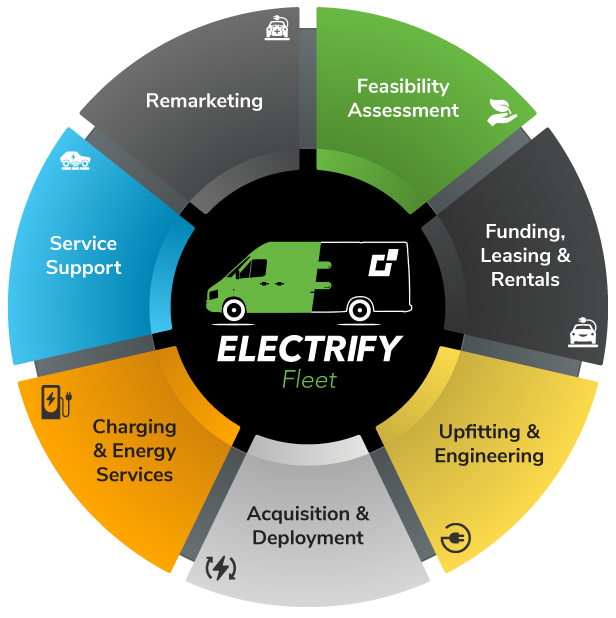7 Fleet Services Needed for Successful EV Implementation
This winter has been packed with announcements from major OEMs about their commitments to electric vehicles, marking the latest wave in what has been a continued shift toward electrification. Due to increased availability & diversity of EV models, a higher impetus to implement sustainability policies & incentives, more focus on corporate social responsibility, and reduced cost of ownership, the time is now for fleets to begin developing strategies for electrification.
The key to a smooth transition to electric vehicles is upfront planning and a clear analysis of current and projected operational needs, taking into account each stage of the vehicle lifecycle – from acquisition to disposition – and having the right services in place to support your operations at each stage. Here are seven fleet services to source when you’re preparing to transition to EVs.

1. Feasibility Assessment
The first step to transitioning to EVs is to assess your vehicle mix and fleet application and determine when a transition is feasible. Fleets with sedans, SUVs and light duty vehicles are likely to transition faster than fleets with medium or heavy-duty vehicles. Work with a fleet management company [FMC] to conduct a thorough feasibility assessment, which includes:
- In-depth analysis of current usage patterns
- Future growth projections
- Review & analysis of required range, payload, and upfit specs
- Projections for total cost of ownership
- Maintenance, charging & service support availability
Based on this assessment, you will have a better sense of which vehicles to change to EVs and when.
2. Fleet Funding, Leasing & Rental
In addition to traditional leasing, funding, and rental options, factors such as tax credits or incentives can impact the financial picture. Your fleet financing partner should be able to assess whether your fleet can benefit from these incentives and how they impact your overall bottom line. While initial funding costs are likely to be higher, the ongoing expenses of operating EVs will be lower than their internal combustion engine [ICE] counterparts. Work with your FMC to estimate when your breakeven point will be. Also consider that funding for any charging infrastructure required will need to be factored in, as it will be different than funding for the vehicle itself.
3. Fleet Upfit & Engineering
New EV technology means new methods of upfitting vehicles. Also, certain EV models will support upfitting while some others may not. If your application relies on proper upfitting to get the job done, then upfront planning to select the right chassis, plus having the right upfitting partners with the right expertise, will be critical to understanding whether EVs can be upfitted to meet your fleet’s particular needs. Look for an FMC that can manage the entire upfit process and ensure the vehicle is delivered in a state where it’s ready for service.
4. Fleet Acquisitions & Deployment
After you’ve selected the right EVs for your fleet application, you need a dedicated team to source, order, and ship those vehicles. New OEMs, like Rivian and Lordstown, and new EV models like the 2022 Cadillac Lyriq continue to enter the market, so look for fleet partners that work with a wide variety of OEMs and have extensive dealer networks to get you the models you need.
It’s also important to note that order-to-delivery windows can be extended for EVs, and there will be a limited supply of EVs in the near future to meet increasing demand. Work with your FMC to plan ahead and place reservations as far as advance in possible. For some models, this may mean placing your reservations now so you’re prepared for when EVs are expected to go into service.
5. Charging & Energy Services
When choosing and deploying EVs, charging infrastructure and energy services is a significant part of the equation. Deciding between vehicles that use AC or DC charging, determining if you need to install on-site charging, and understanding the full picture of your energy service options are all important aspects of making sure your EVs stay running. Understanding your use case is important, too. If employees take their vehicles home, you will need to explore home charging with reimbursements for electricity costs. If vehicles return to a central location every day, a depot model with level 2 and DC fast charging may be a better fit. Addressing your charging questions now will help future-proof your organization, reduce additional labor costs, and improve operational capacity.
6. Service Support
Servicing and maintaining EVs requires a different service network and approach than their ICE counterparts. While EVs are known for their ease of maintenance (no oil changes and fewer moving parts), they will still need to be maintained, and in the case of a breakdown you need to know your service network has EV-trained technicians at the ready. It’s important to find out if the vehicles you select can be serviced locally in their area of operation. Ask your FMC partner if they can handle EV servicing and if there is a dealer or service network available for your fleet.
7. Fleet Remarketing
There are two sides of the remarketing coin to consider: remarketing current fleet vehicles that are phased out for EVs, and remarketing EVs in the future when their replacement date arrives. Your existing fleet can be a source of cash to help finance the transition to EV models. This is especially true right now, as the market is strong and fair market values remain high. When it comes to remarketing EVs, the timeline for remarketing is projected to be longer because EV lifecycles are longer. Much like other aspects of EV services, remarketing is another area where it pays to plan ahead.
Making the transition to EVs must be done strategically, and planning ahead will present your greatest chance of success. This will allow you to account for all fleet service aspects and time each phase appropriately. Even if your fleet isn’t quite ready for EVs to hit the road yet, the future is closer than you think. Companies that prepare for an electric future today will be best equipped to reap the full cost savings and benefits of EVs.





